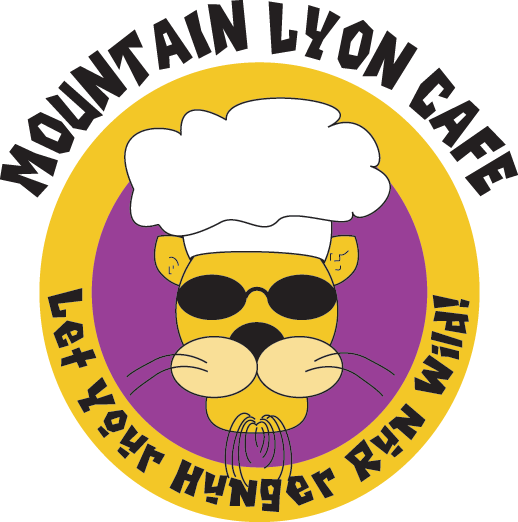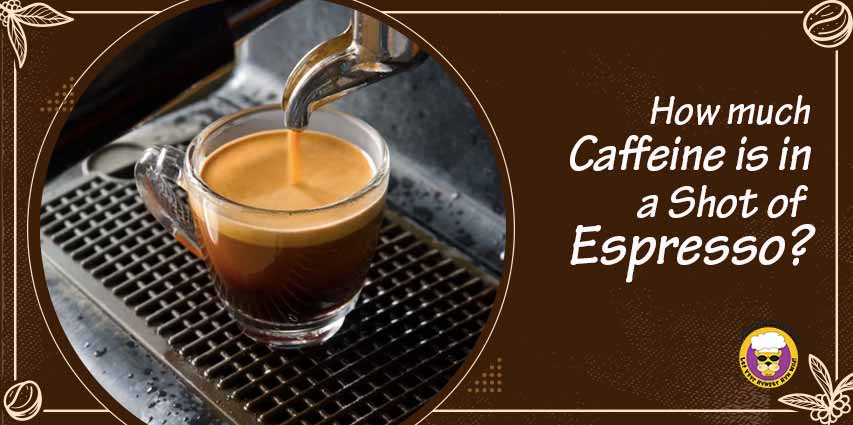Have you ever wondered how much caffeine is in a shot of espresso? If so, then you’re not alone. Caffeine is the world’s most widely consumed psychoactive drug, and an estimated 80% of adults worldwide consume some form of it every day. While coffee offers a higher amount than other coffee beverages, espresso has become increasingly popular as consumers opt for its smaller size and richer flavor.
So let’s find out just how much caffeine power lies within one shot – everything from what goes into making espresso to the exact milligrams revealed!
What Is an Espresso?
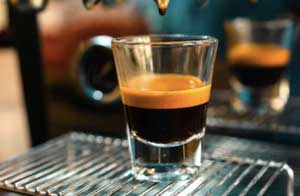
Espresso is a concentrated form of coffee made by forcing hot, pressurized water through finely ground, tightly packed coffee beans. It is typically thicker and more caffeinated than other forms of coffee. A single shot of espresso (1–1.75 ounces) contains around 63 milligrams of caffeine on average, although this can vary depending on the type and roast of bean used.
How Is Espresso Different from Other Coffee Types?
Espresso has a much higher concentration of caffeine than other coffee beverages. It is made with finely ground coffee beans, which are packed tightly into the Portafilter and exposed to high pressure water (around 9 bars). This results in a stronger, thicker coffee that has more caffeine than regular coffee.
Which Coffee Has the Least Caffeine?
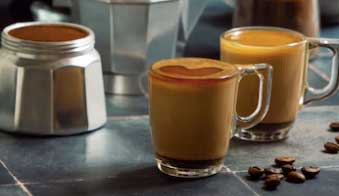
As mentioned, espresso has the highest concentration of caffeine among coffee beverages. But if you’re looking for something with less caffeine, then drip coffee or cold brew are your best options. Drip coffee typically contains around 115 milligrams per cup, while cold brew offers an even lower amount – about 1/3 to 1/2 the amount of espresso.
Which Kind of Espresso Has the Least Caffeine?
As with other types of coffee, the caffeine content of espresso can vary depending on the type and roast of bean used. Generally speaking, dark roasts have slightly less caffeine than light roasts. However, there is no definitive answer as to which kind of espresso has the least amount because there are a variety of variables that influence it.
How much Caffeine is in a Shot of Espresso?
A single shot of espresso typically contains around 63 milligrams of caffeine on average, although this can vary depending on the type and roast of bean used. Drip coffee and cold brew generally offer lower amounts of caffeine than espresso, with drip coffee containing around 115 milligrams per cup and cold brew offering an even lower amount – about 1/3 to 1/2 the amount of espresso.
Related article:
Latte vs Espresso: 6 Key Differences (Method, Volume, Flavor)
How Much Caffeine in 4 Shots of Starbucks Espresso?
A 4-shot espresso drink at Starbucks contains approximately 264 milligrams of caffeine, depending on the type of beans used. This is equivalent to nearly 3 cups of regular brewed coffee. It is important to note that Starbucks also offers other espresso drinks such as cappuccinos and lattes which contain additional ingredients which may affect the overall caffeine content.
Is Espresso the Most Caffeinated Coffee?
Yes, espresso is the most caffeinated type of coffee. It is made by forcing hot, pressurized water through finely ground, tightly packed coffee beans and typically contains around 63 milligrams of caffeine per single shot (1–1.75 ounces). This is much higher than other forms of coffee like drip or cold brew, which generally have lower amounts of caffeine per cup.
Some Benefits of drinking Espresso?
Drinking espresso provides a variety of benefits, including increased energy and alertness, enhanced focus and productivity, improved metabolism, and greater physical endurance. Due to its high levels of caffeine and antioxidants, espresso can also provide health benefits such as reducing the risk of Alzheimer’s disease and diabetes.
Espresso vs. Coffee: 4 Key Differences?
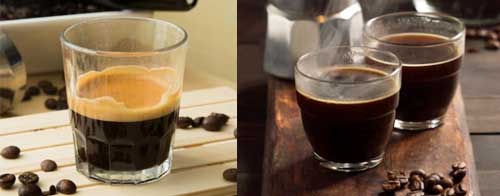
- Caffeine content: Espresso has a much higher concentration of caffeine than other coffee beverages.
- Taste: Espresso typically has a bold, intense flavor compared to regular brewed coffee.
- Preparation: Espresso is made with finely ground beans and exposed to high pressure water (around 9 bars) which results in a stronger, thicker coffee than regular brewed coffee.
- Serving size: Espresso is typically served in smaller amounts (1–1.75 ounces) compared to other types of coffee which are generally served in larger portions.
Overall, espresso provides a stronger and more intense flavor than regular coffee and is associated with a variety of health benefits. It also contains higher levels of caffeine which can provide an energy boost. Therefore, it is important to consider your individual tastes and preferences when deciding between espresso or coffee.
Espresso vs. Coffee: Which Has More Caffeine?
Espresso has more caffeine than regular coffee. A single shot of espresso typically contains around 63 milligrams of caffeine on average, while a cup of drip coffee contains around 115 milligrams per cup and cold brew offers an even lower amount – about 1/3 to 1/2 the amount of espresso.
The Different types of Espresso Drinks and their Caffeine levels?
The caffeine levels in espresso drinks vary based on the type of coffee beans used and their roast. Generally, dark roasts contain slightly less caffeine than light roasts. The most popular types of espresso drinks include:
- Espresso: contains around 63 milligrams of caffeine per single shot (1–1.75 ounces).
- Cappuccino: contains around 70 milligrams of caffeine per cup.
- Latte: typically contains between 75-150 milligrams of caffeine per cup, depending on the size and type of coffee beans used.
- Macchiato: contains around 100 milligrams of caffeine per cup.
- Americano: contains around 115 milligrams of caffeine per cup.
- Mocha: contains around 140 milligrams of caffeine per cup.
- Breve: typically contains between 150-200 milligrams of caffeine per cup, depending on the size and type of coffee beans used.
- Cold Brew: contains around 1/3 to 1/2 the amount of caffeine compared to espresso.
Again, there is no definitive answer as to which coffee type has the least amount of caffeine due to a variety of variables that influence it. It is important to note that these amounts are estimates and may vary depending on the type and roast of beans used.
The Type of Coffee Beans Used?
The type and roast of beans used can affect the caffeine content of coffee. Generally, light roasts tend to have more caffeine than dark roasts due to their lighter color and longer brewing time.
Caffeine Content in Espresso Versus Coffee?
Espresso contains more caffeine than regular coffee, with a single shot containing around 63 milligrams of caffeine on average. A cup of drip coffee typically contains around 115 milligrams per cup and cold brew offers an even lower amount – about 1/3 to 1/2 the amount of espresso.
Cream Content in Espresso?
Cream is not typically added to espresso drinks, however it can be used in some specialty drinks to add flavor and richness. Milk or cream can also be added to espresso-based drinks such as cappuccinos and lattes. If you are looking for a lower calorie option, opt for non-dairy milk alternatives such as almond or soy milk.
Overall, it is important to remember that there is no definitive answer as to which espresso drink has the most or least amount of caffeine due to a variety of variables that influence it. It’s best to consult with your barista and inquire about the type of coffee beans used and their roast before selecting an espresso drink.
FAQs
What type of coffee has the least amount of caffeine?
There is no definitive answer as to which coffee type has the least amount of caffeine due to a variety of variables that influence it. Generally, light roasts tend to have more caffeine than dark roasts, while cold brew offers an even lower amount compared to espresso.
Does espresso have more caffeine than regular coffee?
Yes, espresso contains more caffeine than regular coffee, with a single shot containing around 63 milligrams of caffeine on average. A cup of drip coffee typically contains around 115 milligrams per cup and cold brew offers an even lower amount – about 1/3 to 1/2 the amount of espresso.
What are some health benefits of drinking espresso?
Due to its high levels of caffeine and antioxidants, espresso can provide health benefits such as reducing the risk of Alzheimer’s disease, Parkinson’s disease, and certain types of cancer.
Can cream be added to espresso?
Cream is not typically added to espresso drinks, however it can be used in some specialty drinks to add flavor and richness. Milk or cream can also be added to espresso-based drinks such as cappuccinos and lattes. If you are looking for a lower calorie option, opt for non-dairy milk alternatives such as almond or soy milk.
What is the difference between a Ristretto, Lungo, and Normale espresso shot?
Ristretto is an Italian term meaning “restricted” or “limited.” It is a short espresso shot made with half the amount of water but double the amount of coffee grounds. It is a stronger, more concentrated type of espresso that typically has a more intense flavor and crema.
Is 2 shots of espresso a lot of caffeine?
Two shots of espresso contain about 126 milligrams of caffeine, which is considered to be a moderate amount. If you are sensitive to the effects of caffeine, it’s best to start with one shot and work your way up from there. It is also important to remember that different types of coffee beans can have varying levels of caffeine content, so it is best to consult with your barista and inquire about the type of coffee beans used before selecting an espresso drink.
How much caffeine is in a single shot of espresso?
A single shot of espresso contains around 63 milligrams of caffeine on average. A cup of drip coffee typically contains around 115 milligrams per cup and cold brew offers an even lower amount – about 1/3 to 1/2 the amount of espresso. It is important to remember that different types of coffee beans can have varying levels of caffeine content, so it is best to consult with your barista and inquire about the type of coffee beans used before selecting an espresso drink.
How much milk can be added to espresso?
Milk or cream can be added to espresso-based drinks such as cappuccinos and lattes in varying amounts depending on personal preference. If you are looking for a lower calorie option, opt for non-dairy milk alternatives such as almond or soy milk. It is important to remember that adding more liquid will dilute the espresso and reduce its caffeine content.
Is 200 mg of caffeine a lot?
200 mg of caffeine is considered a moderate to high amount and may cause adverse effects in some individuals. It is important to remember that everyone’s tolerance for caffeine can vary, so it’s best to start with smaller amounts and gradually increase as needed. If you experience any negative side effects from consuming caffeine, it is recommended to reduce or stop your intake.
How many mg is 2 shots of espresso?
Two shots of espresso contain about 126 milligrams of caffeine on average. This can vary depending on the type of coffee beans used, so it is best to consult with your barista and inquire about the type of coffee beans used before selecting an espresso drink. It is also important to remember that everyone’s tolerance for caffeine can vary, so it’s best to start with smaller amounts and gradually increase as needed.
Can espresso be made at home?
Yes, you can make espresso at home using an espresso machine or a stovetop moka pot. Manual espresso machines are typically more affordable than electric ones, but they require the user to grind their own coffee beans and manually tamp the grounds. Electric espresso machines are typically more expensive but tend to be easier to use as they come with built-in grinders. Moka pots can also be used to make espresso, though they require some practice and technique to get the best results.
How many espresso shots equal a cup of coffee caffeine?
Generally speaking, one espresso shot contains around 63 milligrams of caffeine on average. This is roughly equal to a cup of drip coffee which typically contains around 115 milligrams per cup. Cold brew offers an even lower amount – about 1/3 to 1/2 the amount of espresso.
How much caffeine in a double shot of espresso?
A double shot of espresso contains around 126 milligrams of caffeine on average. This can vary depending on the type of coffee beans used, so it is best to consult with your barista and inquire about the type of coffee beans used before selecting an espresso drink.
Caffeine in Espresso vs Coffee
Espresso typically contains more caffeine than coffee, with a single shot of espresso containing around 63 milligrams of caffeine on average. A cup of drip coffee typically contains around 115 milligrams per cup and cold brew offers an even lower amount – about 1/3 to 1/2 the amount of espresso.
How much caffeine in 4 shots of espresso?
Four shots of espresso contain around 252 milligrams of caffeine on average. This can vary depending on the type of coffee beans used.
Coffee caffeine content vs espresso
Espresso typically contains more caffeine than coffee, with a single shot of espresso containing around 63 milligrams of caffeine on average. A cup of drip coffee typically contains around 115 milligrams per cup and cold brew offers an even lower amount – about 1/3 to 1/2 the amount of espresso.
Caffeine in drip coffee vs espresso
Drip coffee typically contains around 115 milligrams of caffeine per cup, while a single shot of espresso contains about 63 milligrams on average. Cold brew offers an even lower amount – about 1/3 to 1/2 the amount of espresso.
How much caffeine should you have in a day?
Most experts suggest that adults should consume no more than 400 milligrams of caffeine per day. It is important to note that everyone’s tolerance for caffeine can vary, so it’s best to start with smaller amounts and gradually increase as needed.
How much caffeine is too much?
Consuming more than 400 milligrams of caffeine per day can lead to adverse side effects such as insomnia, headaches, restlessness, and jitteriness. Depending on your individual sensitivity to caffeine and other factors like age, weight, and health conditions, certain individuals may need to further limit their intake or avoid caffeine altogether.
Conclusion: How much caffeine is in a shot of espresso?
In conclusion, it can be said that espresso shots have a relatively high amount of caffeine when compared to other coffee beverages. One shot of espresso contains about 77 mg of caffeine, which is almost twice as much as the same volume of brewed coffee. While these numbers may seem insignificant at first glance, they add up very quickly and should be taken into account when trying to manage intake levels.
Moreover, regular consumers of espresso, especially those with any pre-existing health conditions should be especially mindful since high levels of consumption can lead to negative impacts on their well-being. Finally, if you’re looking for a great espresso shot and want peace of mind regarding caffeine levels, consider buying an organic variety certified by the Rainforest Alliance or another recognised certifying organisation – your health will thank you!
I’m Kara Chavez, and I love coffee. I like to create some of the best coffees around – espressos, lattes, macchiatos – you name it. I strive for perfection in my coffee-making skills, and I take great pride in providing a delicious cup of joe to my customers.
I’ve been working in the coffee industry for years now, and I know everything there is to know about making a perfect cup of coffee. My passion for coffee shines through in every cup that I make, and I hope that you’ll stop by soon so that I can share my love of coffee with you!
